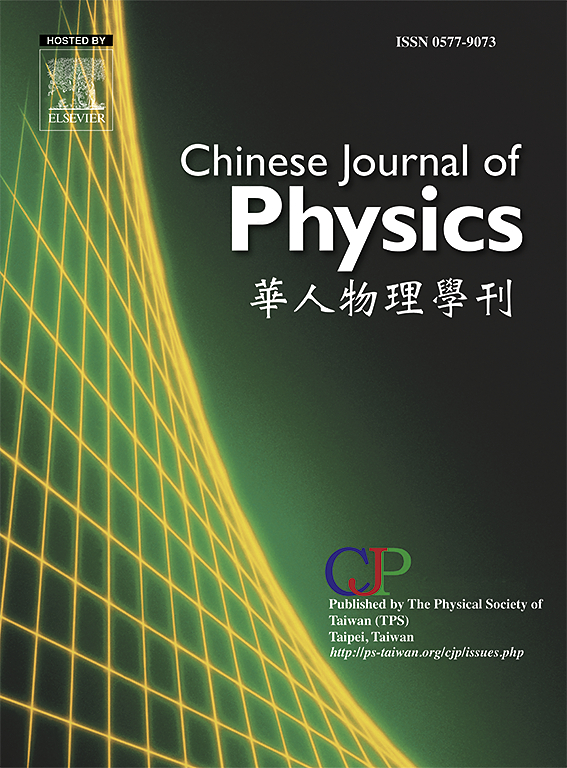渗透边界和温度依赖粘度对含尘铁磁流体饱和多孔层热不稳定性的影响
IF 4.6
2区 物理与天体物理
Q1 PHYSICS, MULTIDISCIPLINARY
引用次数: 0
摘要
本研究考察了具有温度依赖粘度的含尘铁磁流体饱和多孔层中渗透边界对热对流的影响,考虑了三种不同的粘度变化规律:线性、指数和反比。渗透边界和温度依赖粘度的结合为多孔含尘铁磁流体系统的热对流研究提供了一个新的理论扩展。进行了线性稳定性分析,并采用Pellew和Southwell的技术来验证稳定性交换原理,确认不稳定性通过平稳对流模式发生。用单项伽辽金方法求解了平稳对流的特征值问题。该研究调查了不同流体动力条件下各种参数对对流开始的影响,为系统稳定性提供了关键见解。可以观察到,控制边界渗透率的参数(k0′,k1′),以及表征多孔介质的参数(Das−1)和Brinkman数(Λ)都延迟了对流的开始,从而发挥了稳定作用。相反,磁化参数M3和粉尘颗粒参数h′的非线性促进对流,导致相反的效果。温度依赖的粘度变化参数δ在线性和指数变化下增强了稳定性,但在逆变化下引起不稳定。此外,还分析了这些参数对对流池尺寸的影响。以前的研究结果被检索为本分析框架内的特殊情况,加强了结果的有效性。本文章由计算机程序翻译,如有差异,请以英文原文为准。

Influence of permeable boundaries and temperature-dependent viscosity on thermal instability in a dusty ferrofluid-saturated porous layer
This study examines the influence of permeable boundaries on thermal convection in a dusty ferrofluid-saturated porous layer with temperature-dependent viscosity, considering three distinct viscosity variation laws: linear, exponential, and inverse. The incorporation of permeable boundaries and temperature-dependent viscosity introduces a novel theoretical extension to the study of thermal convection in porous dusty ferrofluid systems. A linear stability analysis is performed, and Pellew and Southwell’s technique is employed to validate the principle of exchange of stabilities, confirming that instability occurs via a stationary convection mode. The eigenvalue problem for stationary convection is solved using a single-term Galerkin method. The study investigates the influence of various parameters on the onset of convection under different hydrodynamic conditions, providing key insights into system stability. It is observed that parameters governing boundary permeability (), as well as those characterizing the porous medium () and the Brinkman number (), delay the onset of convection, thereby exerting a stabilizing effect. In contrast, the non-linearity of the magnetization parameter () and the dust particles parameter () promote convection, leading to the opposite effect. The temperature-dependent viscosity variation parameter () enhances stability for linear and exponential variations but induces destabilization under inverse variation. Additionally, the influence of these parameters on convection cell size is analyzed. The findings of previous studies are retrieved as special cases within the framework of this analysis, reinforcing the validity of the results.
求助全文
通过发布文献求助,成功后即可免费获取论文全文。
去求助
来源期刊

Chinese Journal of Physics
物理-物理:综合
CiteScore
8.50
自引率
10.00%
发文量
361
审稿时长
44 days
期刊介绍:
The Chinese Journal of Physics publishes important advances in various branches in physics, including statistical and biophysical physics, condensed matter physics, atomic/molecular physics, optics, particle physics and nuclear physics.
The editors welcome manuscripts on:
-General Physics: Statistical and Quantum Mechanics, etc.-
Gravitation and Astrophysics-
Elementary Particles and Fields-
Nuclear Physics-
Atomic, Molecular, and Optical Physics-
Quantum Information and Quantum Computation-
Fluid Dynamics, Nonlinear Dynamics, Chaos, and Complex Networks-
Plasma and Beam Physics-
Condensed Matter: Structure, etc.-
Condensed Matter: Electronic Properties, etc.-
Polymer, Soft Matter, Biological, and Interdisciplinary Physics.
CJP publishes regular research papers, feature articles and review papers.
 求助内容:
求助内容: 应助结果提醒方式:
应助结果提醒方式:


